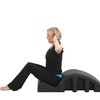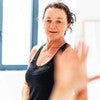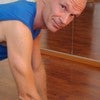Description
About This Video
Transcript
Read Full Transcript
I'm Debra lessen and we're doing a tutorial on eve gentry's breastbone breathing. Assisting me today is Neidra Gabriel, who's going through this for the first time along with you. Um, so to define what we're doing, the idea of breastbone breathing is to get a forward and back motion in the mid thoracic spine. But I want to expand this idea a little bit for general thoracic mobility and also start employing it in movement so that you can identified when and where you're, you are actually employing this idea. So first I'm just going to ask me a dre, um, to put her fingertips right in the middle of her breastbone. And as you inhale, your fingers should rise up and as you exhale they should drop down toward the mat. So also on the inhalation, if you feel your fingers opening apart, that's excellent. And on your exhalation you want to feel that the back is widening.
So again, inhale. Now as she keeps breathing, I just want to explain to you that um, many people particularly type a personalities, people who have desk jobs who are in one position all day long, um, don't move in this area of their body and it affects the entire body. So for our health, we really have to open up and get things moving in the thorax. Okay, so now I'd like you to turn on your stomach and we're going to do the same thing prone. You can put your hands one on top of the other, under your forehead. Okay, so I'm putting my fingers in her mid thoracic spine. And as you inhale, my fingers go up toward the ceiling.
And as you exhale, think of the chest broadening and the spine dropping into the mat. Excellent. So inhale up to the ceiling. Exhale, the sternum is dropping, the chest is widening and the spine is dropping. One more time. Inhale. Good. And exhale. Now we're going to carry this breathing into movement of the head.
So on her next exhalation, first we want to let her soften and start dropping. And then you're going to send you nose forward and crawl your eyes high up the wall onto the ceiling. Now let me just hold that position for a minute. Lengthen up through here. That's it. So I want you to peel off, but I don't want you to lose the length of the back of the neck. Now delay your head and you're going to come down one vertebra at a time and the head is the last.
Exhale, delay the head. And as she rolls down, she's moving away from the tail, so she's actually elongating in two directions. One more time. Good. Exhale, drop. Send the head forward. Inhale high up. And you want to feel a very strong connection between the Ha, the crown of the head and the tail. And exhale, move away from the tail. Let your elbow slide forward if they want to. Good. And now just stay down on the mat and you can continue breathing. All right, so that was excellent.
Now we want to make a constant relationship between this breathing and movement of the head. All right, so every time you need to lift your head, you want to think of going forward through the thoracic spine. So now I want you to stay right where you are in your mid back. Take both legs off the mat, straight legs. Keep your hands attached to your head. Think of going forward through your sternum and peel the upper body off and just stay here nice and long through the back of the neck.
Good shoulders are open. Shoulder blades are sliding down in the back, but never locked down onto the back and just take some good deep breaths too. You're going to inhale, expand through the mid back, stay up, but on your exhale, drop through the mid thoracic spine. That's it. Inhale, expand, exhale, drop. Good. Again, inhale, expand, exhale, drop. And just hold for a minute. So in this position, I want you to feel that your mid thoracic spine and your tailbone are moving away from each other. She is actually standing on four feet right now.
And those are her two hipbones and her two bottom ribs. What we're trying to teach out of is thinking of raising the head or raising the upper body by immediately going into the lumbar spine. Okay. We have lots of history with problems with that and you can come down and just shake out. Good. Okay. So let's have you come up on your forearms.
You're going to make a tripod with your forearms. That's it. All right, now we're, we're staying in one position, but the breathing is going to make her, um, get much deeper and much more muscular support in this position. So on your inhalation, you're going to widen on your exhalation. You're going to go forward through your mid thoracic spine. That's it. And every time you go forward, your antennas are going to go higher up to the ceiling. So inhale, Wyden, exhale, sternum forward, and press down on your forearms. That's it. So your spine is projecting up to the ceiling. Again, inhale and exhale forward and up.
Now we're going to add the opposite movement. So on your exhalation, take a deep breath. First on your exhalation, you're going to round back into here. That's it. This is small. Let the head follow round as far down as you can without taking your hips off the mat.
And now you're going to inhale going forward through the sternum high up through the crown of the head, pressing down through the arms. She's engaging her entire abdominal wall to support her in this position. Good. So on your exhale, round, feel length from the tail to the crown of the head. And actually you're pushing with your arms in this space. And now as you reverse, you're going to go forward.
Pull with the arms and press high up. And think of the exercises you do. Weightbearing on your arms, on the reformer. They chair, always pressing your body up out of your arms. One more time. Exhale round. Excellent. And inhale forward. Nope, don't drop.
So you want to stay open here and now go forward and up that cit so you can go forward more, but don't drop into your shoulder blades once more. Exhale round. You get that. I always say once more and go forward and high up. That's it. So you're going higher. Good and roll all the way down. Good. Let your arms slide out and just rest for a minute. Do a little wiggle waggle okay, that was excellent.
All right, now I want you to take your arms by your sides. Hands next to your shoulders. All right. This is not the grasshopper position that you usually see. I want your hands wide enough that you can get your whole forearm down on the floor and let the shoulders open and drop. That's it. Forehead is down.
So we're going to carry the same idea into a little more movement. You're going to inhale into your mid thorax on the drops and your neck, your head forward. Come as high as you can when you can't come higher. Keep coming up from here and press with your arms. Good crown of the head is now going back to the soles of the feet.
Don't drop that set. Stretch the arms all the way. Now you're not going to drop. You're going to pull your elbows back towards your hips and roll from the bottom to the top. Keep the crown of the head toward the souls of the feet. Good. The face is going to be the very last to come down. Elbows all the way down and let those shoulders open and drop.
So inhale into your back. Exhale, drop project the head forward. Crown of the head comes up to the souls of the feet. You're pushing with your arms. Your abdominal wall is supporting the body. Good. Stay high up. Don't drop the back of the head. So this is a big arc. Okay, and now pull your elbows back towards your hipbones right along your ribs.
Don't drop the head. Keep projecting the face forward. Now knee Edra is looking around in her body for this movement because she's incredibly hyper mobile in her neck. And if you are hyper mobile, it's even more important that you find this through a line of energy and not through a position. Good. Let your shoulders come all the way down. One more time. Inhale, exhale, go forward. Imagine you're tracing up the wall with your nose and then you're tracing up onto the ceiling. Good.
Stretch the arms all the way that sit and pull the elbows back towards your hipbones. Imagine your sternum going all the way out through the window. There is a window in front of her and out into the Pacific Ocean. Good and rest. Very good. Okay, so let's have you turn over on your back again. Uh, come down foot word a little bit and now you're going to take your hands behind your head. Okay. So I want you to in a comfortable position, you could do this with your legs propped up or you look straight down on the mat. So now on your inhalation, think of expanding through the ribcage. On Your exhalation, you're going to soften and drop your chest down into the mat.
Good. And inhale, come all the way back down. So I just want to point out that knee Edra did something that I thought would have to be another tutorial, which is as she rounds her upper spine, she automatically rounds her pelvis under. That's excellent. Thank you. Okay, so should I be doing that or not? Yes you should because we can't segment the spine. It's not healthy movement. All right, so inhale open through the rib cage. On the exhale, just think of dropping so that your spine is actually imprinting onto the mat.
Good. And then on your inhale, roll back down. Good. And just keep going. You can do a few more. So all of our Palati selection exercises, this is what we're doing. I like the image of a Stegosaurus, sticking all of its platelets out in the back. So, and that's the true idea of imprinting. It's not a position. Good. Once more. Exhale. Good.
And now stay there and extend your legs, but keep your pelvis in a slight curve. Good. Reach your arms forward.
Take a deep breath and roll down one vertebra at a time. Good. Now if you're new to pull oddities or you feel that you have neck problems and you're unable to start from this position and round forward, don't start from this position. Start from sitting. Good. So come and sit all the way up at the top here. Good. And now exhale, soften.
So we want her mid thoracic spine immediately dropping back. The same as she's doing in her low back. Soften, soften. That's it. Now only go down to your bottom ribs. That's it. Take a deep right where you are. Exhale, drop more and come forward. Come forward. That's it. And stay right where you are. Inhale and exhale.
Roll just halfway down. So you only go down as far as you have the strength to control without gripping. Take a breath into your back. Exhale, soften and come back up. Okay, so this is actually what teaser is. X. Exhale, scoop and roll down.
Good. Come forward. Inhale up. Sternum is traveling in the opposite direction. So we're all very visual and many of us see an arch and we immediately think of moving backward in space. But actually what we need to think about is moving forward through the sternum to go back and inhale and let's just make it a little bigger. So those of you who work on the trapeze table, this is what we do with the roll down bar and come high up and you can go further back. I'll give you a little more help and inhale up.
And again, as you build the strength, the movement can get bigger, come all the way to the bottom. And let's come from the bottom. Inhale up. Good. You can go a little further back, but without a huge arch that sit and lift through the sternum and center and rest. Thank you.
Comments
A question however, is exhaling through the mouth unimportant in this exercise.
You need to be a subscriber to post a comment.
Please Log In or Create an Account to start your free trial.




















